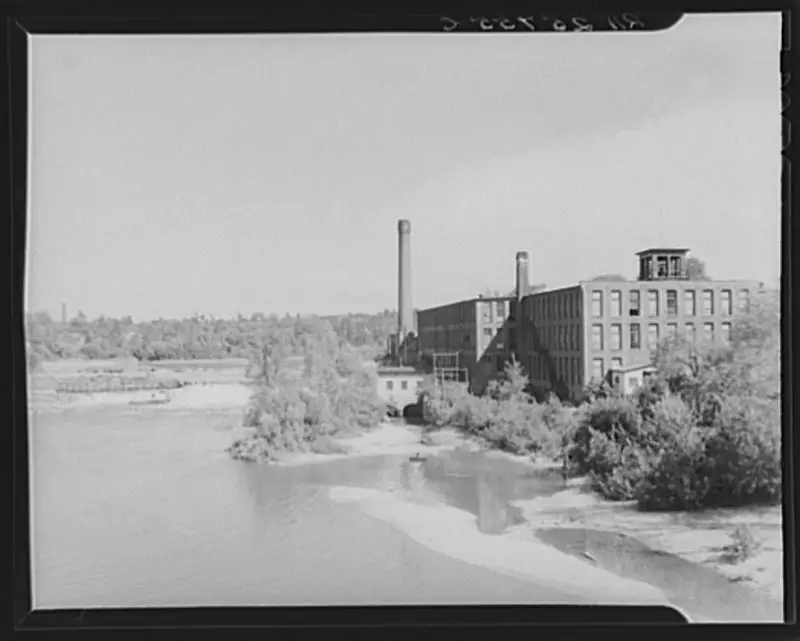Factories in the North

The industrial revolution began in England and then expanded to the New England states around 1812. Textile mills were built along rivers using water-power and then later with steam-power.
This started a centralization of the workforce so that all of the products were made in one location. As factories grew, the people that were once individual artisans creating a product were replaced by mechanization with wage laborers creating many products.
The factory concept quickly expanded into other U.S. areas, and the era of the factory began.
As factory production increased in the 1800s, it became clear to the factory owners that paying unskilled labor low wages would benefit them with more profit.

This labor often included women and children and copied many of the labor practices that the British used.
- Factories began to implement different labor groups, each one doing part of the job of creating the whole product. Factories often hired entire families that were unskilled, each family member doing a particular part of the job. This was called “putting-out” as it used families that were farmers that were experiencing losses due to the competition with the Midwestern farms.
- The farming families would be under contract to merchants and make some of the parts on their farms. These included parts for shoes, hats, some pottery and weaving, furniture, knit stockings, and blankets.
- In the early days of the industrial revolution, Great Britain had more textile machines and mills than the colonies. This led to dependence upon England for many of the goods Great Britain didn’t want factories in the New World. It banned anyone that had knowledge of building and running the machines and factories from immigrating. This didn’t stop people as some made their way and became pioneers of factories focusing on water-powered cotton mills and other textile industries. One of the first to travel to the U.S. was Samuel Slater, a British mechanic.
- Slater’s success convinced others to invest in the new factories, and they began building them for the textile industry at first and then other industries later. Some rather odd laws were passed for hiring and paying, one of them being the “Rhode Island system.” This was a condition where an entire family would be hired, with the father in charge of the family as a manager. Instead of cash payments, the father received “credit” for his and his family’s work that could be exchanged for goods purchased at the company-owned store or rent at the company-owned housing.
- A number of situations happened over the next years that affected the creation of factories in the U.S. and how they operated. The War of 1812 and the Embargo of 1812 prompted the increase of factories at home. The embargo stopped the merchants in the U.S. from being involved in sales in the Atlantic trade. The war added to already reduced profits by the merchants in the U.S. Some merchants had previously relied on English factories, and now they were building factories in America.
- The new factories in the U.S. began employing and training more workers but also instituted some of the newest technology machines that took over some of the jobs previously done by people. Workers were forced to live in company-owned towns, and this gave the companies full control over the workers.
- By the 1830s, the Mill Worker Rules and Wages were created by Michel Chevalier, an engineer of the French government that examined factories in the U.S. and Mexico. The rules were strict with high requirements, and the low wages that were paid were specified for each job.
- While cotton and woolen cloth was the basis for most of the U.S. industrial revolution, other factories copied their methods in most of the growing states. These included the production of shoes, leather tanning, papermaking, gun making, and hat making. Mechanization greatly added to the profits as it required very few employees to take care of an entire plant.
- As more U.S. factories turned out more home-created products, there was an increase in consumer spending. This was the beginning of the real idea of “supply and demand” and the institution of the true consumer. In less than fifty years, the average home changed from a bare and often poor existence to one that shared many benefits such as parlor stoves for heat, family clocks, and rooms that oil lamps for light.
- It wasn’t until a number of years later that the workers began to organize in unions, demand higher wages, and refused to live under the company-owned conditions.
Q&A:
How did early factory owners make more profit with their workers?
Using unskilled labor
What were the two events that effected the profits of U.S. factories in 1812?
The War of 1812 and the Embargo of 1812
What was the Rhode Island system?
An entire family would be hired, with the father in charge of the family as a manager and only the father got paid in “credits”
What did Michel Chevalier create in the 1830s that set down a more defined idea of expectations of workers and how they were paid?
Mill Worker Rules and Wages
What happened to American life as more products were made in American factories?
Improvement of life
What did the success of factory production in the United States eventually lead to workers?
Union organization, improved wages, and rejection of company-owned conditions



